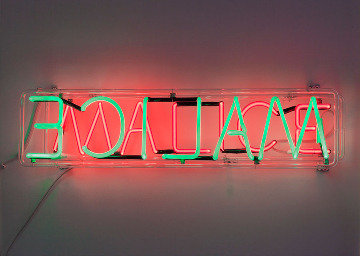Bruce Nauman
dal 20/5/2015 al 31/7/2015
Segnalato da
20/5/2015
Bruce Nauman
Gagosian Gallery, Paris
Selected Works from 1967 to 1990. His rigorous, ascetic engagement with the existential dichotomies of life/death, love/hate, pleasure/pain has embraced performance, video, holography, installation, sculpture, and drawing.

Gagosian Paris is pleased to present key works by Bruce Nauman spanning three decades.
Since the 1960s, Nauman's radical interdisciplinary approach has challenged conventions while producing new methodologies for creating art and meaning. His rigorous, ascetic engagement with the existential dichotomies of life/death, love/hate, pleasure/pain has embraced performance, video, holography, installation, sculpture, and drawing. From the attitudes and forms of his Post-Minimalist and Conceptual work to his most recent sound installations, persistent themes and ideas appear: the use of the body as material; the relationship between image and language, art and viewer; and the generative interaction of positive and negative space.
William T. Wiley or Ray Johnson Trap (1967) is an early example of Nauman's resourceful and at times afflictive manipulation of the body. During a visit to his former professor William T. Wiley's home, a bundle of mail art by Ray Johnson arrived. Nauman arranged the odds and ends sent by Johnson—shoelaces, a scarf, a matchbook—around Wiley's body as he lay on the floor; when Wiley arose, he photographed the peculiar silhouette. What appears to be a snapshot of strewn accoutrements is in fact a fleeting "trap" in which he engages two of his conceptual forebears.
In Audio Video Piece for London, Ontario (1969–70), Nauman uses a closed-circuit television, a camera, and an audio recording to confuse sensory perception. The television broadcasts images of an adjoining room. Rhythmic noises emanate from the inaccessible space, prompting the question of why it appears completely empty on-screen. Conceived a decade later, the geometric steel sculpture Dead End Tunnel Folded into Four Arms with Common Walls (1980–87) similarly conveys disconnection and miscommunication. The “dead ends” represented by a floor-bound steel cross provide a primitive architectural maquette for a dysfunctional space, echoing Nauman's Corridor installations of the 1960s and 1970s, in which viewers encountered disorienting passages leading to nowhere.
Beginning in the mid-1960s, Nauman exploited the ubiquity of neon signage to produce “art that would kind of disappear, an art that was supposed to not quite look like art.” He created luminous wordplays that alluded to tensions both individual and social, but which challenged viewers to find their own resonance. In Malice (1980), the foreboding noun is illuminated in red neon tubes, obscured behind its inverted spelling in green. The jumbled letters may suggest malice that has gone unnoticed, or imperviousness to violent acts.
Animal Pyramid (1989) is a stack of seventeen taxidermy molds rising to twelve feet. The carnivalesque arrangement of these alien creatures made out of amber-hued polyurethane evokes the dichotomy of nature and sport: four upside-down foxes crown graduated rows of deer and caribou, eerily featureless—even ambiguous—without their prized pelts and horns. The entire ensemble is visibly cobbled together with wire, the work of a morbid puppeteer. Like the preceding work Carousel (1988)—where dismembered taxidermy forms hang and drag from a steel axis that turns in an agonizing danse macabre—the sculpture disturbs with its vision of carnage submitted to an artificial and bloodless geometric order.
In the deadpan Setting a Good Corner (Allegory and Metaphor) (1999), a single, later articulation of his most enduring subjects, Nauman films himself constructing a fence at his ranch in New Mexico. Recalling his performances of the 1960s such as Walking in an Exaggerated Manner Around the Perimeter of a Square (1967–68) and Bouncing in the Corner (1968–69), he uses a repetitive physical task—in this case, a necessary one for property maintenance—to determine the narrative and duration of a performative work. Dislodging art from the paradigm of the highly crafted object, Nauman predicates his ongoing conceptual inquiry on the spaces, words, politics and idiosyncrasies of unfiltered reality.
Bruce Nauman was born in 1941 in Fort Wayne, Indiana. His work is represented in public and private collections worldwide. Solo exhibitions include “Bruce Nauman: Inside Out,” Museo Nacional Centro de Arte Reina Sofía, Madrid (1993–94, traveled to Walker Art Center, Minneapolis; Museum of Contemporary Art, Los Angeles; Hirshhorn Museum and Sculpture Garden, Washington, D.C.; and Museum of Modern Art, New York, through 1995); “Bruce Nauman: Mapping the Studio I (Fat Chance John Cage),” Dia Center for the Arts, New York (2002); “Mapping the Studio,” Museum für Gegenwartskunst, Basel (2002); “Bruce Nauman: Theaters of Experience,” Deutsche Guggenheim, Berlin (2003); “Bruce Nauman: Raw Materials,” Unilever Commission, Tate Modern Turbine Hall (2005); “A Rose Has No Teeth: Bruce Nauman in the 1960s,” UC Berkeley Art Museum and Pacific Film Archive, Berkeley, CA (2007); “Notations/Bruce Nauman: Days and Giorni,” Biennale di Venezia (2009, traveled to Philadelphia Museum of Art; and Museum of Modern Art, New York (through 2010); “Bruce Nauman: Dream Passage,” Hamburger Bahnhof, Berlin (2010); and “Bruce Nauman's Words on Paper,” Art Gallery of Ontario (2014). His work has been included in the Whitney Biennial (1977, 1985, 1987, 1991, and 1997); and the Venice Biennale (1978, 1980, 1999, 2005, and 2007). Nauman lives and works in Northern New Mexico.
“Bruce Nauman,” an exhibition of early installations and recent works never previously seen in France, is on view at Fondation Cartier pour l'art contemporain, Paris through June 21, 2015.
Image: Bruce Nauman, Malice, 1980, neon tubing with clear glass tubing, 7 × 29 × 3 inches (17.8 × 73.7 × 7.6 cm), ed. of 3 © Bruce Nauman/Artists Rights Society (ARS), New York
Press Contact:
Edouard Pradère à edouard@gagosian.com ou au +33.1.75.00.05.92.
Opening: Thuersady 21 May 6pm
Gagosian Gallery
4 rue de Ponthieu
75008 Paris
Hours: Tue–Sat 11-7



